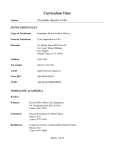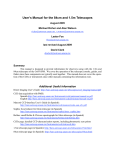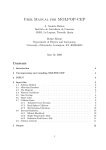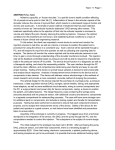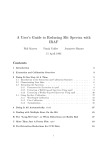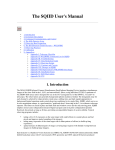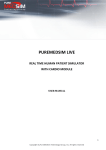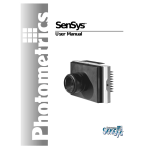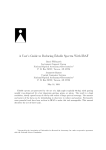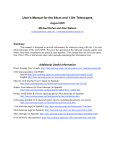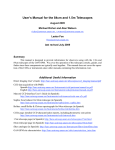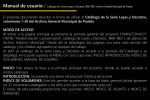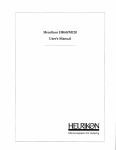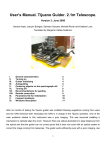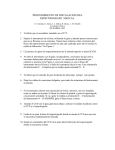Download A Taste of ESPRESSO or How to Use The San Pedro Martir REOSC
Transcript
A Taste of ESPRESSO or How to Use The San Pedro Martir REOSC Echelle Spectrograph S. Levine Observatorio Astronómico Nacional IA-UNAM, Ensenada, B.C., Mex. [email protected] and D. Chakrabarty California Institute of Technology Pasadena, CA, USA IA-UNAM TECHNICAL REPORT # MU-94-04 submitted 24 August 1994 1.0a - revised 4 October 1994 1.0b - revised 20 April 1995 version 1.0b Contents: 1. Spectrograph Characteristics 1.1 General Information 1.2 The Cameras 1.3 Efficiency and Response 2. How to Adjust the Spectrograph for Your Needs 2.1 Focusing the Spectrograph 2.2 Changing the Wavelength Region 2.3 Rotating the Slit 3. Basic Procedures for Taking Spectra 1 of 22 3.1 How To 3.2 Taking Standard Star Spectra 4. The UCL Camera 4.1 UCL Camera Specifications 4.2 Positioning the Spectrum 5. The REOSC Camera 5.1 REOSC Camera Specifications 5.2 Positioning the Spectrum 5.3 Moving the Focal Plane Stage 6. Detectors 6.1 The CCD-Mil 6.2 The CCD-Tek 6.3 The CCD-UMass 7. General Caveats 8. Appendix - Some Basic Optics 9. References and Other Useful Documents 10. Pictures of the Spectrum List of Tables List of Figures 1. Spectrograph Characteristics (Contents| Next Section) The Echelle Spectrograph at San Pedro Martir (SPM) was constructed in the late 1970's by the French Optical firm of REOSC. The echelle is capable of a resolution of R ~ 18,000 at 5,000Å, with either of its two camera/detector setups. This translates into a 2 pixel velocity resolution of roughly 17 km/s A note on the choice of name. The echelle (unlike the newer instruments at San Pedro) has not been graced with a name other than to call it ``the echelle'' (at least as far as the author is aware). While writing this manual, I had a free moment to ponder this terrible state of affairs, and propose to call the echelle ESPRESSO (for ESPectrografo Reosc Echelle de Sierra San pedro martir, Observatorio or if you prefer, Echelle SPectrograph from REosc for the Sierra San pedro martir Observatory). Thus, this is the ESPRESSO User's Guide, and if you like, you can tell your friends that you are up on the mountain using the ESPRESSO Machine. 1.1 General Information The layout of the main optical elements of the spectrograph is shown in Figure 2 of 22 1, and the instrument controls in Figure 2. The main echelle grating is ruled on a 254mm×128mm area, and has 79 lines/mm. The blaze angle is 63°433, and the incidence angle is 71°. The beam is dispersed into an angle of ±2°63. The dispersion depends upon the order, and ranges from 4Å/mm to 16Å/mm. The values differ slightly depending upon which of the two available cameras you are using (see the sections on the two cameras - ucl or reosc). The two grating cross-dispersers available are listed in Table 1 . The 900 lines/mm cross-disperser (B) was most useful when the detector was a photographic plate. With a CCD (and its much smaller detector surface area), the 300 lines/mm grating (A) is more useful. With this, it is possible to fit between 8 (near Halpha) and 16 (near 4,000Å) orders onto the chip with the REOSC/UMass setup, or between 12 and 30 orders onto the UCL/Mil setup. The current default setup uses cross-disperser A, with the UCL camera and the CCD-Mil detector. There are half a dozen comparison lamps available (see Table 2). The lamp housing has three permanently mounted lamps, and one hole that permits the easy interchange of additional lamps. Currently mounted in the permanent sockets are lamps of Argon, Cesium and Rubidium. In the open hole, a Thorium-Argon lamp (with its own voltage supply) can be mounted. The flat lamp mounting socket also fits in the same hole, and Neon and Helium-Argon bulbs can be fitted into this socket. On the underside of the lamp housing, a sliding diffuser is mounted. To insert the diffuser, push up (in). It should click into position. This is used with the flat lamp to help ensure even illumination of the slit. The most commonly used comparison lamps currently are the Th-Ar and the He-Ar. Each of the permanently mounted lamps has a switch on the lamp housing. There is a mirror in the housing that can be rotated to select which lamp is reflected onto the slit assembly. The mirror can be pulled out (and should be) when using light sources that mount in the open socket (the flat lamp, the Th-Ar, He-Ar, etc.). To remove the mirror from the light path, pull outward on the knob which rotates the mirror. The spectrograph has a continuously adjustable slit , with a minimum slit width of 30µm, and a maximum of 900µm. Presuming that you are using the f/7.5 secondary, the plate scale 1.33×10¯²''/µm. The optimum slit width (matched to 2 pixel resolution) is close to 2 arcseconds (150µm) (see Table 11 in the appendix). We present some typical slit sizes in microns and arcseconds in Table 3. 3 of 22 The slit viewer observes an 18 mm diameter field around the slit. An intensified CCD camera that can be used to view the slit is currently being tested out. This replaces the eyepiece, and should allow the observer to both acquire objects and guide on the slit (the ability to guide on the slit is dependent upon the slit size used). As it exists now, the camera has no difficulty reaching tenth magnitude objects (as faint as I have seen tried) and should be able to image at least as faint as twelfth magnitude for useful guiding. The slit length is 30 mm (6'.7) but it can be shortened using a series of masks or deckers. The masks typically come in pairs, and there are 10 masks all together. Each pair consists of a central mask, and a double mask positioned outside the central mask. This permits the observer to make two non-overlapping exposures on the same image (subject to the inter-order spacing). The widths of the masks are given Table 4. Pulling the mask slide all the way out (beyond mask position 10) permits the user to view the whole slit length (or at least the full field of view of the slit viewer eyepiece). Which mask you use is dependent upon the wavelength region you wish to observe. The further towards the blue you wish to observe, the more closely spaced the orders become, thus limiting the length of the slit that you can effectively use without getting overlap of the orders. The cross disperser and camera optics magnify the image of the length of the slit (see the appendix), just as the echelle grating and camera optics magnify the slit width (hence the derived optimum slit width). In Figure 3, the distance between the order centers is plotted, and overlaid upon that are dashed lines showing the length of the slit as it actually appears on the detector. For the orders NOT to overlap, the inter-order spacing must be greated than the image length. So, with the 2 mm mask (#7), all the orders redward of order 50 (lambda > 4400Å) should not overlap. Of course, you will want to leave some space between the orders, so effectively, this means that you should not go all the way to order 50. At 4200Å the maximum slit length for no overlap is 1 mm = 13''.3 (decker number 8, see the Figure accompanying Table 4 and also Figure 3 ). 1.2 The Cameras There are now two cameras available for use with the echelle. The first has been recently constructed at University College London, and is paired with a 1024×1024 CCD detector (either the CCD-Mil or the CCD-Tek). We shall refer to this system as the UCL camera. This is the current default configuration for the echelle. The second camera is the original REOSC camera, which is used with a 4 of 22 512×512 CCD run by a system put together by Photometrics (CCD-UMass). We shall call this combined camera and CCD setup the REOSC camera. 1.3 Efficiency and Response Be aware that there is a very wide range in response with wavelength of the system as a whole (including the CCD), and it is likely that some regions of your spectra will be saturated while others are barely exposed. The blaze functions for the first order of the cross dispersers are shown in the top panel of Figure 4, along with the typical blaze function along each of the echelle orders (bottom panel). To help point out somewhat more the wide dynamic range of the system as a whole, Figure 5 shows first the (panel 1), and the the product of the QE and the cross disperser A blaze function (panel 2). To illustrate how these might combine with some typical input spectra, panel 3 shows black body spectra for objects of temperatures 3200°K (an approximation of a tungsten flat lamp) and 5800°K (roughly solar), and panel 4 shows what the relative output intensities would be. Note that the total relative intensities are better than you will actually get, since we have not included transmission and reflection loss from all of the rest of the various optical elements. How long do you need to integrate to reach a given Signal to Noise ratio (S/N) for a given magnitude? S/N(lambda) = sqrt[e¯/(pixel in echelle dispersion direction)] = sqrt{[gamma = # photons above the atmosphere/(s cm² Å)] × [epsilon = % transmission of atmosphere, telescope, & echelle] × [A = collecting area = pi r² (cm²)] × [Delta x = Å / pixel] × [QE = e¯ / photon] × [t = integration time in seconds] } We can re-write gamma in terms of V magnitudes (lambda = 5556Å) as gamma(V) = 948 × 10^{-V/2.5} photons/(cm² s Å) , where the 948 is the number of photons from a star of magnitude V=0.(Actually, this is the monochromatic flux at 5556Å, but for a rough estimate it will be close enough. See Mihalas & Binney, 1981,Galactic Astronomy, p. 62.) So, S/N(lambda) = sqrt{ 948 × 10^(-V/2.5) × epsilon A (Delta x)(QE) t }. 5 of 22 For the 2 meter telescope at SPM, at 5,000Å, A=31416cm². With the UCL camera and CCD-Mil chip, (Delta_x) = 0.14Å/pixel. We'll assume that the CCD QE is about 15%, and that the combined transmission epsilon~6% (this presumes 90% transmission or reflectance at every optical element and through the atmosphere, and 40% at each of the gratings). When combined with the QE of the CCD this gives a throughput of just under 1%. So, the S/N(lambda) will be S/N(lambda) ~ sqrt{ 39,000 × 10^(-V/2.5) t × e¯/(pixel in echelle dispersion direction)}. This is the S/N you should get after you sum together the pixels dispersed in the spatial direction. For those who cannot do this, divide this number by the number of pixels in the cross-disperser direction (let us estimate it at 4 for ease of illustration) making the S/N(pixel)=1/2×S/N(lambda). The example above is probably a bit optimistic. Remember too that the S/N is also going to depend upon the wavelength, and the spectral structure of the object under study. You are advised to take several spectra of various magnitude objects to get an empirical value for the constant term in the S/N relations, which are summarized below: (a) S/N given V and t, (b) t given S/N and V, (c) V limit given t and S/N. (a) S/N = sqrt { const × 10^(-V/2.5) t } (b) t = (S/N)² × 10^(V/2.5) / const (c) V = -2.5 log10 [(S/N)² /(const × t)] 2. How to Adjust the Spectrograph for Your Needs (Contents| Next Section| Prev. Section) First, don't forget to focus the telescope. 2.1 Focusing the Spectrograph In addition to focusing the telescope, it is also necessary to make sure that the spectrograph is focused. The spectrograph is focused by moving the collimator using the micrometer on the bottom of the instrument housing. The telescope should be pointing at or near the zenith for focusing. This procedure can be done fairly rapidly with two people, and should be done everytime the dewar is removed and replaced. We found that once done in the early evening, the focus would remain ok for the rest of the night. The smallest line widths (FWHM) you will realistically be able to achieve are about 2.5 pixels. 6 of 22 To focus: 1. Turn on an arc lamp, push in the knob on top of the lamp housing, and set up a small slit (say about 40µm - the key point here is really only that the slit be small enough that the CCD pixel size, not the slit width limits the resolution - see the appendix and Table 11). 2. Unlock the collimator by loosening the three set screws spaced around the side of the housing. These should only be finger tight. 3. The collimator should now be free to move. It is moved by turning the knob of the micrometer found on the bottom of the instrument housing. This micrometer can be difficult to turn. 4. Take an image, noting the micrometer setting. 5. Turn the micrometer 0.5 or 1.0 turns and take another image. 6. Repeat (4) and (5) until you have acheived a satisfactory focus. Be aware that the optimum focus settings may be slightly different for the red and the blue ends of the spectrum. 7. Tighten the set screws by hand when you have a good focus. 2.2 Changing the Wavelength Region To access different wavelength regions, you will need to rotate the cross disperser. On your images, you will see that this causes motion perpendicular to the dispersion direction of the orders. The cross disperser angle is set with a circular micrometer on the lower side of the instrument housing. Course adjustment is done by loosening the right thumb screw and turning the grating holder by hand. Fine adjustment is done using the left thumb screw. The right hand thumb screw should be tightened before doing fine adjustment. Using the vernier, you can read the grating tilt angle to one minute of arc. Maps of grating angles, blaze wavelengths and visible orders are given in each of the sections on the two possible camera setups. 2.3 Rotating the Slit To rotate the echelle slit, the whole instrument is rotated on the telescope mounting. There are two locking knobs and a third knob that causes the mounting platen to rotate. There is an angle indicator next to this knob. Check the value when you begin. Usually the spectrograph is mounted with the slit pointing in an east-west direction. There are two reasons you might wish to rotate the slit. The first and obvious one is to orient the slit in a particular direction on an extended object. The 7 of 22 second reason is that you may wish to minimize the differential refraction due to the atmosphere (see paper by Filippenko, A. 1982, PASP, vol. 94, p.715). These two objectives are not usually compatible, and those of you doing intensity measurements are advised to read Filippenko's paper and see if this will make a big difference for you. 3. Basic Procedures for Taking Spectra (Contents| Next Section| Prev. Section) 3.1 How To In the course of taking data with the echelle spectrograph, you will need to know how to take flat and bias frames and arc lamp and object images. Bias frames are simple and easy to take, and do not depend upon the settings of the echelle. Note however, that the dome should be dark, as the whole system is not totally light tight, and if you take a bias with bright lights on in the dome, you will notice a gradient in the bias images (this has been seen with both the CCD-Mil and the CCD-UMass). There is also some scattered light in the system. When taking flat field images, you have several options. You can use the internally mounted flat lamp, which is (I believe) a tungsten bulb (so the effective temperature of the spectrum is around 3200°K, see Figure 5) or you can take dome flats, which seem to be slightly bluer, but take much longer to reach the same saturation level (they are fainter by roughly a factor of 10). Sky flats have difficulty with solar and atmospheric lines in the spectrum. Note that the response of the system, and the QE of the CCD and the temperature of the typical flat image lamp all conspire to cause a very wide range in intensity with wavelength, and you will very likely need exposures of long and short duration to properly fill the wells in the blue and red respectively. The flats are typically used for two things, correcting for the response of the CCD, and correcting for the blaze functions of the gratings. They should be taken with the same instrumental setup up that your data are taken with. To take a flat field using the internal lamp: 1. Go up to the instrument. Put the flat lamp into the lamp holder. Remember to push in the diffuser (the slide is found on the underside of 8 of 22 the lamp housing), and pull out the rotating mirror. The diffuser helps to ensure even illumination of the slit. 2. Push the knob on top of the lamp housing IN. This reflects the lamp light down through the spectrograph slit, and blocks out the optical path from the telescope. 3. Set the desired slit width, and choice of mask. 4. Take an n second exposure, where n is long enough to mostly fill, but not saturate the image. For images of the comparison lamps , you are presented with a plethora of possibilities, but the most commonly used lamps currently are the Thorium-Argon lamp and the Helium-Argon lamp. (G. Koenigsberger, G. Canalizo and D. Peña have recently compiled a Th-Ar atlas using this echelle. In addition, there are two high resolution line atlases are available for the Th-Ar lamp, one from the AAT and one from KPNO, and J. Echevarria has compiled a He-Ar lamp atlas using this echelle.) To take a spectrum of a comparison lamp: 1. Choose the comparison lamp you wish to use, and turn it on. Remember to rotate the mirror to the proper setting, or to pull it out if you are using one of the bulbs that mounts in the same holder as the flat lamp, and if necessary to push in the diffuser. 2. Push the knob on top of the lamp housing IN. This reflects the lamp light down through the spectrograph slit, and blocks out the optical path from the telescope. 3. Set the desired slit width, and choice of mask. 4. Take an n second exposure. Typically for the Thorium-Argon lamp, a 60 second exposure is long enough to give well defined lines. Now, go find your objects! For fainter objects, you may well find it necessary to take several shorter exposures and co-add the images later, since the number of cosmic rays in a 15 minute exposure is fairly high. To take a spectrum of an astronomical object: 1. 2. 3. 4. Turn off all the lamps. Pull the knob on the lamp housing OUT. Set the desired slit width, and choice of mask. Take an n second exposure. Depending upon the wavelength region you are working in, you may need to insert a long pass filter to block out overlap from the second and third orders 9 of 22 of the cross-disperser. We use the first order of the cross-disperser to separate the echelle orders. Second and third order images also show up on the image plane. For stellar spectra, this is not a problem shortward of about 6,500-7,000Å, since the atmosphere effectively blocks transmission of much of the radiation short of 3,000Å. However, if you wish to observe further towards the red, you will want to have a long pass filter to remove the second and third order spectra. For the comparison arcs, technically this is a problem for all the echelle orders, since you don't have the atmosphere to cut out the violet, though the first order is substantially brighter than the second and third orders. While we do not currently have an optical quality long pass filter, some tests have already been made with a photographic wratten filter placed in a temporary mounting behind the slit assembly. 3.2 Taking Standard Star Spectra For absolute flux calibration, you will need standard star spectra. The spectrophotometric standards given by P. Massey, K. Strobel, J. Barnes and E. Anderson (1988, ApJ, 328, 315) are available on line in IRAF, along with several other sets of spectrophotometric standards. When in IRAF, type ``page onedstds$README'' to see a listing of the standards. Copies of the finder charts for the Massey et. al. standards should be in the control room. 4. The UCL Camera (Contents| Next Section| Prev. Section) 4.1 UCL Camera Specifications The UCL camera was recently constructed at University College London to replace the original REOSC camera. First observations with the new camera were done in the fall of 1993. The camera has a focal length of 215.6 mm. This camera is used with the CCD-Mil (see section 6.1) and the CCD-Tek (see section 6.2). This camera setup is capable of observing between 3,000Å and 11,000Å, though not all at once. For orders 74 through 34 (the blue end from about 3,000Å to about 6,700Å, including Halpha in order 34, Hbeta; in order 46, Hgamma in order 52, and Hdelta) the CCD can be set to cover the complete free spectral range. For wavelengths longer than about 6,700Å (orders 33 through 20), the percentage of coverage steadily decrease until in order 20, 10 of 22 only about 5/8 of the free spectral range is on the chip. According to J. Echevarria, it is possible to cover the entire range from 3,000Å to 11,000Å in three or four overlapping frames: Orders 74 through 41, 40 through 27 and 26 through 20. To observe redder than Halpha, it is necessary to insert a filter to cut out the overlap from the second and third orders. 4.2 Positioning the Spectrum To determine what portion of the spectrum is imaged onto the CCD, you can rotate the cross-disperser using the rotating micrometer on the side of the echelle housing. See Table 5 for a list of which wavelength regions are imaged onto the CCD at which micrometer angles. Figure 6 illustrates where the orders lie on the camera focal plane, and the box shows the size of the CCD. Note that you get the full free spectral range for all orders bluer than order 34. 5. The REOSC Camera (Contents| Next Section| Prev. Section) 5.1 REOSC Camera Specifications The REOSC camera has a focal length of 204 mm, and is constructed of a spherical plate mirror with a double lens afocal correcting plate and a field lens. It has a flat field of 8° × 5°2 with an f/1.4 focal ratio. The blur circle is less than 15µm\ for every wavelength in the whole field. The central wavelengths of the orders are given in Table 8. Because of the short focal length of the camera, it is necessary to guide the light from the focal plane to the CCD using a fiber optic bundle. The only CCD equipped with the necessary fiber bundle is the CCD-UMass (see section 6.3). The CCD is not quite large enough to encompass the whole free spectral range of most of the orders, so provision is made for moving the CCD mounting stage. Details of how to do this are given below. 5.2 Positioning the Spectrum To determine what portion of the spectrum is imaged onto the CCD, you can rotate the cross-disperser using the rotating micrometer on the side of the echelle housing. See Table 7 for a list of which wavelength regions are imaged onto the CCD at which micrometer angles. Figure 7 illustrates where the orders lie on the camera focal plane, and the box shows the size of the CCD. 5.3 Moving the Focal Plane Stage 11 of 22 Because CCD-UMass is not big enough to capture overlapping orders, it is possible to move the stage that the CCD is mounted on roughly parallel to the echelle dispersion direction. This is accomplished using the micrometer mounted on the left hand side of the dewar (when facing the instrument from the dewar side). Move so that the micrometer is directly in front of you. To move the stage, you first loosen the two brass colored bolts on the left and right sides just below the stage. Now, you can move the stage by turning the micrometer. This micrometer is calibrated in inches, not meters. Attached to the micrometer is a digital readout that can be zeroed at any position. This makes it easy to change back and forth between stage positions. When you are done moving the stage, don't forget to tighten the locking nuts. 6. Detectors (Contents| Next Section| Prev. Section) A note before we begin: the gain factor and CGAIN are NOT the same thing. The gain factor (f) is just that, the ratio of the number of electrons/ADU relative to the number of electrons/ADU when the A/D converter's range equals the full well depth. Hence, a gain of 1 implies that the A/D converter should saturate when the CCD's wells fill. A gain factor of 2 implies that the A/D converter saturates at half the well depth etc. The CGAIN that many of the control programs use is a holdover from the Photometrics control systems. CGAIN is related to the gain, typically by a formula like CGAIN = C_1 × (f - 1) + C_2 where the constants C_1 and C_2 vary depending upon the CCD and controller. C_1 is usually either 15 or 30 and C_2 either 0 or 11 (see IA-UNAM Technical Report #102). 6.1 The CCD-Mil The CCD-Mil system features a Thompson THX31156 CCD with a Metachrome II coating to improve blue response. It has 1024×1024 pixels, each 19µm×19µm. This chip is most sensitive in the red; its quantum efficiency at 7,000Å is about 40%, and at 4,000Å is about 15%. See Figure 5, panel 1 for the quantum efficiency curve. According to Photometrics, the well depth is 173,000 electrons, and the A/D converter has a range from 0 to 2^14-1 = 16,383, meaning that the A/D conversion factor is 10.6 e¯/ADU at a gain of 1. The readout noise is 5.71 12 of 22 electrons. The normal bias level at -110°C is 275 ADU at gain factor of 1. (See the Photometrics specifications for this chip as well as IA-UNAM Technical Reports # 97 and # 102 for more information.) The constants for conversion from gain factor (f) to CGAIN are C_1 = 15 and C_2 = 11 for this chip. Note though that as it is implemented in the elmil control program, C_2 = 0, so that a gain factor of 1 is entered as CGAIN=0 and a gain factor of 5 is entered as CGAIN=60. (See Table 9.) A warning to users who are observing faint objects, this chip has charge transfer problems, which you will most likely see on one edge of your orders. The CCD-Mil chip is run using the elmil program on the Sun workstations or using a photometrics control program on a PC. The elmil program is pretty much self-explanatory (except for the section on setting the gain factor), and is documented by L. Gutierrez in the user's manual (see also IA-UNAM Technical Report #97, though the system documented there is not being used). The elmil control program does not seem to have facility for a continual chip flush between exposures. You may wish to take a few biases to clear the wells after a bright exposure. 6.2 The CCD-Tek The CCD-Tek system is also supplied by Photometrics and is constructed around a Tektronix TK1024AB CCD with a Metachrome II coating to improve the blue response. It has 1024×1024 pixels, each 24µm×24µm. The quantum efficiency is between 30% and 40% between 2,500Å and 5,000Å, and then climbs to 65% at 6,000Å before declining to 50% longward of 8,000Å and finally 30% between 9,000Å and 10,000Å. See Figure 5, panel 1 for the quantum efficiency curve. The full well depth is 319,000 electrons, and the A/D converter resolution is 2^16, from 0 to 65,535 ADU's, giving a unit gain of 4.88 e¯/ADU. The bias level at gain of 1 is 944 ADU, and the tested dark current at the operating temperature of -100°C is 0.76 e¯/pixel/hour. (See Table 10.) This system is being documented by J. A. Lopez. 6.3 The CCD-UMass The CCD-UMass system has been assembled and packaged by Photometrics, 13 of 22 and the whole package is referred to as a Photometrics 3000 system. The detector in the CCD-UMass camera is a Ford Aerospace PM 512 CCD (this division of Ford Aerospace has since been sold to the Loral Corporation). It actually has 516×516 pixels, each 20µm×20µm, though the user can only use 512×512. The CCD wells are 250,000 electrons deep, and the A/D converter has a dynamic range from 0 to 2^14-1 = 16,383 ADU's. Readout noise is between 7 and 12 electrons/pixel rms, and the unit gain (with CGAIN=0) is 15 e¯/ADU (IA-UNAM Technical Report #102). A fiber optic bundle is cemented to the face of the chip. This bundle is made up of 5µm fibers in roughly hexagonal sheaves. The operating temperature range is -90°C to -130°C, with typical temperatures being -101°C and -110°C. If the dewar is filled at the beginning of the night, the charge will normally last all night. Once the temperature of the CCD system stabilizes, the temperature probably won't vary by more than than 0.1°C over the course of the night. The gain conversion factors for this CCD are C_1 = 30 and C_2 = 0. 6.3.1 Basic Operation The computer control for the CCD-UMass system is a Heurikon Systems computer running a system V version of the Unix operating system. The CCD control software is called ccd_oan, and is a FORTH interpreter written in C. Usually you will find the Heurikon up and running, but just in case, we now tell you how to (re-)boot the computer (see IA-UNAM Technical Report #61 for more details). 1. Turn on the power to the computer. The switch is on the front of the box that says Photometrics 3000. Turn on the HDS terminal (this is the computer console). 2. When the ``>'' prompt appears, type ``bw <return>''. This begins the boot-strap process. 3. After several messages, the computer will say ``Standalone boot''. At the ``:'' prompt, type ``<return>''. 4. Several more messages will scroll by, and then the computer will prompt you with ``type return to start at 0x100''. You type ``<return>''. 5. Finally, the basic unix system will be up and running in single user mode, and the system will say ``Welcome to UNIX System (7a)'' and display a ``#'' prompt. At this point, you should type ``init 2''. This will tell the system to initialize multi-user mode. 6. The computer will next ask if you wish it to check the file system. You should answer ``y<return>'', unless you know for sure that the file system 14 of 22 is ok and uncorrupted. The checking should take no more than 3 to 5 minutes. 7. Presuming all has gone well, the next prompt you receive will be a standard UNIX login prompt, ``login:''. Log on as ``ccd'' (no password). Congrats, the computer is now up, and ready to run the CCD control program. 8. Type ``ccd_oan'' to start up the FORTH interpreter that controls the CCD. Since you know how to start the computer, you should also know how to shut it off (in case the power goes out for example). Shut down is a much simpler procedure. 1. If you are in ``ccd_oan'', type ``quit'' to exit. 2. At the UNIX prompt ``%'' type ``su <return>''. This will log you in as the root user. You will now have the access necessary to shut down the computer gracefully. 3. At the UNIX prompt ``#'', type ``sync <return>''. Now, type it again. 4. You should now turn off the power on the computer box labeled Photometrics 3000, then the power to the HDS terminal and the Cabel graphics terminal, and finally the power on the tape drive. CCD control commands are listed in the Photometrics 3000 Users Manual, but for convenience, we list a few of the most commonly used ones. bias This takes a bias frame. cisc This starts up the cycle that continuously clears the CCD. obs n This takes an exposure of n deciseconds duration. N.B.: DO NOT type cisc during an observation!!! Doing so will cause the control program to lock-up, and the only apparent solution is to re-boot the computer. pcol n Plot column n of the current image. prow n Plot row n of the current image. qshow This displays an image on the image display. N.B.: If you will be saving full frame images to disk, there is only enough space on the disk for about 50 images, so plan ahead. Also, while the software makes no mention of it, the Heurikon only has enough RAM to hold 6-7 15 of 22 images in memory at one time. 7. General Caveats (Contents| Next Section| Prev. Section) a) light leak - with the dome lights on, or the slit open during the day, you will notice a gradient in the bias frames. This should go away pretty much as soon as the lights go out. It may take several minutes, and you should probably do a cisc on CCD-UMass to flush the chip wells. The bias should be very flat, typically at about 310 ADU. On the CCD-Mil, try taking a series of bias frames to acheive the same objective (since there doesn't appear to be a cisc equivalent). b) dome slit openings - It is not possible to have the whole slit open. There are 3 possible configurations: 2 doors down, which cuts off the lower 40 degrees (roughly); 2 doors up, which cuts off about 30 degrees from the zenith; and 1 up and 1 down. It takes about 10 minutes to change between door configurations. c) high humidity - If the humidity climbs above about 70%, condensation begins to form on the face of the fiber bundle that is cemented to the CCD-UMass. This is a time variable phenomenon that can be very noticeable. The face should be cleaned every few hours when this happens. Also be aware that under current observatory operating procedure, the telescope will not be opened if the humidity reaches 85%. d) tape drive troubles - The 9 track on the Heurikon is very finicky about loading tapes. The only apparent solution (short of a serial link or new tape drive) is persistence. The Exabytes on the Suns need to be cleaned on a regular basis. e) warning about the clock settings - (i) on the HEURIKON: The clock on the Heurikon can be set by the user (when logged in as root). Except for the short period between old and new change over dates to daylight savings time, the clock should be displaying Pacific time. The Heurikon actually stores time in UT internally. If the time gets re-set improperly, it will affect the UT that gets written into your FITS image headers by wfits when it writes the images to tape. (ii) on the SUN: The date and time can be set only by the root user. The times written into your FITS images by elmil and/or IRAF will use the system time so make sure it is right. Be aware that the clocks on the computers can drift by up to several seconds per day. There is a WWV receiver up in the 16 of 22 telescope console room. 8. Appendix - Some Basic Optics (Contents| Next Section| Prev. Section) If the set-ups change, or you just feel like checking the numbers given in the tables, we provide for your convenience a few of the more important equations relating to gratings. A few definitions first: is the focal length of the camera. · f_cam · f_col is the focal length of the spectrograph collimator. of grooves per millimeter. · gmisisthethenumber spectral order (and is an integer). · x is the position on the detector measured with respect to the position of · the blaze wavelength. tan(psi) = x/f_cam. is the angle of incidence with respect to the grating normal. · alpha is the angle of diffraction of the blaze wavelength of the order. · beta_0 beta_0 = 2 theta_B - alpha. is the angle of diffraction with respect to the grating normal. beta = · beta beta_0 + psi. is the blaze angle of the grating. · theta_B · lambda is the wavelength in angstroms. is the angle of diffraction away from the angle of diffraction of the · psi blaze wavelength (ie, psi is an angle away from beta_0). We define the blaze angle to be positive, and any angle on the same side of the grating normal is also positive. Any angle on the opposite side of the grating normal is negative (see Figure 8). In the terms defined above, the grating equation is written lambda [Å] = [10^7 Å/mm] {sin(alpha) + sin(beta)} / (g m). The blaze wavelength of an order m is given by the grating equation when psi = 0, so beta = beta_0 = 2theta_B - alpha. The position on the detector (with respect to the position of the blaze wavelength) of any wavelength in the order $m$ can be found by solving the grating equation for psi and thence x, and works out to be 17 of 22 / g m lambda \ x[mm] = f_cam tan { arcsin | ----------- - sin(alpha)| - (2theta_B - alpha) }. \ 10^7 [Å/mm] / The linear dispersion can be derived by differentiating the grating equation with respect to beta and using the chain rule to work out the derivative with respect to x dlambda/dx [Å/mm] = [10^7 Å/mm] {cos(beta)} / (g m f_cam). The free spectral range (FSR) of each order (m) is given by FSR = lambda_blaze / m. For this echelle, for the main grating, as pointed out previously, g=79 lines/mm, theta_B = 63°433, and alpha = 71°, so lambda_blaze [Å] = (2.244615 × 10^5) / m and dlambda_blaze/dx [Å/mm] = (7.10291 × 10^4) / (m × f_cam [mm]) where f_cam = 215.6 mm for the UCL camera and f_cam = 204 mm for the REOSC camera. The intensity in each order relative to that of the blaze wavelength can be described very roughly by I(beta) is proportional to sin²(A) / (A²), where A = m pi { cos(theta_B) - sin(theta_B)/tan((alpha + beta)/2) }. Again inverting the grating equation, we can write beta = arcsin{(g m lambda) / [10^7 Å/mm] - sin(alpha)}, and hence compute I as a function of wavelength. Within the echelle, remember that the spectrum is actually the product of two diffraction gratings, and hence both will affect the final intensity. (See D. Gray, 1976, The Observation and Analysis of Stellar Photospheres, chapter 3 for more on this, as well as the references noted with it in the references section.) Finally, it is often pointed out that aspects other than the diffraction limit of the telescope optics dictate the optimal slit width. The telescope diffraction 18 of 22 limit is roughly 1.22×lambda/D, where D is the diameter of the objective (for the 2 meter telescope, at 5,000Å, this is ~ 1/20''). The internal optics of the spectrograph will magnify the image of the slit on the detector plane, where the resolution is fixed by the pixel size, so the optimal slit is that slit which lets in as much light as possible, while the slit image is no wider than one pixel (roughly). If we have a pure, monochromatic beam of light illuminating the entrance aperture, which has a width w [mm], then the angular size of the image of that aperture on the detector is obtained from the derivative of the grating equation with respect to alpha taken over a finite but small angle Delta_beta = {-cos(alpha)/cos(beta)}× Delta_alpha. To convert to linear measures on the detector (Delta x) and on the telescope focal plane (w) respectively, Delta_beta ~ Delta_x[mm] / f_cam[mm], and Delta_alpha = arctan (w/f_col) ~ w[mm]/f_col[mm]. Putting it all together, w[mm] = {cos(beta)/cos(alpha)} × {f_col/f_cam} × {Delta x[mm]}. For the echelle and camera combinations we have, we find the theoretical optimal slit sizes given in Table 11. (The focal length of the collimator is 720 mm.) Note that the optimal slit width is close to what the typical seeing is at the 2 meter. 9. References and Other Useful Documents (Contents| Next Section| Prev. Section) Bitacoras: There are separate log books for the various instruments as well as the telescope itself. Check all of them, since various observers have recorded their runs in different logs. Manuals: Manual for the Italian Guider (the offset autoguider). Manual for the CCD-Mil/elmil control program, by L. Gutierrez. 19 of 22 Manual for the CCD-Tek by J. A. Lopez Photometrics 3000 Manuals. The UNIX Manual has a listing of the available CCD control commands. The User's Manual has information about the actual hardware. This is for the CCD-UMass setup. IA-UNAM Technical Reports: IA-UNAM Technical Report #35 Espectro de Calibracion del Helio y Argon en Alta Dispersion, en el Intervalo Espectral lambda lambda 3470-5525 Å, y Programas de extraccion de ordenes para el Echelle-Mepsicron, by F. Diego, J. Echevarría and M. Alvarez. This report details the wavelength coverage in each of the orders. It is quite useful in helping the user to get oriented. IA-UNAM Technical Report #61 Instructivo Elemental del Sistema CCD Photometrics 3000, by I. Cruz-Gonzalez and L. Carrasco. This gives details about running the CCD-UMass control system. IA-UNAM Technical Report #97 (March 1992) Instructivo para Observadores en el CCD-MIL, by M. Peña and S. Torres-Peimbert. This gives details for running the CCD-Mil, and some technical specifications (see also the ``elmil'' manual by L. Gutierrez). IA-UNAM Technical Report #102 (March 1992) Ajuste de Ganancia a una Camera CCD, by F. Barbosa. This gives CGAIN to gain factor conversions for the various CCD's available (and seems to be based upon the information supplied by Photometrics). Literature: Filippenko, A. 1982, The Importance of Atmospheric Differential Refraction in Spectrophotometry, PASP, 94, 715 Massey, P., Strobel, K., Barnes, J. & Anderson, E., 1988, Spectrophotometric Standards, ApJ, 328, 315. Atlases: Th-Ar Atlas by G. Koenigsberger, G. Canalizo, and D. Peña. Made with this echelle, using the UCL camera and the CCD-Mil. This atlas been submitted to the IA-UNAM Technical Reports. 20 of 22 Th-Ar Atlas by J. A. Lopez and M. Moreno. Made with this echelle, using the UCL camera and the CCD-Tek. He-Ar Atlas by J. Echevarria. Made with this echelle, using the UCL camera and the CCD-Mil. UCLES Spectrum of the Thorium-Argon Hollow-Cathode Lamp, I. 79 grooves/mm echelle grating and IPCS detector, by M. Bessell and M. Pettini, from the Anglo-Australian Observatory. A useful map of the Thorium-Argon line spectrum done with an echelle similar to this one. A CCD Atlas of Comparison Spectra: Thorium-Argon Hollow Cathode 3180Å - 9540Å, by D. Willmarth, from Kitt Peak National Observatory. Another useful Thorium-Argon line atlas. Spectrograph Characteristics: Any good optics textbook for basic diffraction gratings (Jenkins and White, Born and Wolf, whatever your favorite is). Gray, D., 1976, ``The Observation and Analysis of Stellar Photospheres'', chapter 3. Schroeder, D., 1970, Design Considerations for Astronomical Echelle Spectrographs, PASP, 82, 1253. The next four references go into detail regarding how to properly compute the intensity profile that emerges from an echelle. They are interesting reading and go into much more detail than we have done here. Schroeder, D. & Hilliard, R., 1980, Echelle Efficiencies: theory and experiment, Applied Optics, 19, 2833 Bottema, M., 1981, Echelle Efficiencies: theory and experiment; comment, Applied Optics, 20, 528 Schroeder, D., 1981, Echelle Efficiencies: theory and experiment; author's reply to comment, Applied Optics, 20, 530 Engman, S. & Lindblom, P., 1982, Blaze Characteristics of Echelle Gratings, Applied Optics, 21, 4356 Other Useful Sources: 21 of 22 IRAF noao/astutil/gratings utility and help page. The Manual for the Boller & Chivens Spectrograph. 10. Pictures of the Spectrum (Contents| Prev. Section) To aid in oriention, we provide an echelle spectrogram of the Thorium-Argon lamp and one of the Helium-Argon lamp. For more detailed information, please refer to the various atlases now available. Both the Thorium-Argon and the Helium-Argon echelle spectrograms were taken using cross disperser A, with the UCL camera, and the CCD-Mil detector. The wavelength increases from top to bottom and left to right. The lowest order (and longest wavelength) is thus at the bottom right, and the highest order and shortest wavelength at the top left. With each spectrum, the cross-disperser rotation angle is given (this is the angle read off of the rotating micrometer), and the range in wavelength and order. Several orders in each echelle spectrogram are labeled either on the left or right edge. Thorium-Argon echelle spectrogram courtesy of W. Schuster. Helium-Argon echelle spectrogram courtesy of J. Bohigas. This manual converted from TeX to HTML by S. Levine. Comments, questions, offers to write this page etc. to S. Levine. Regresar 22 of 22























